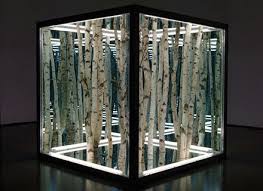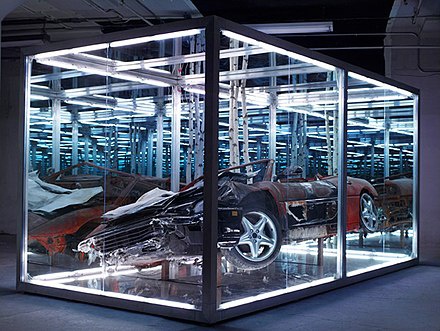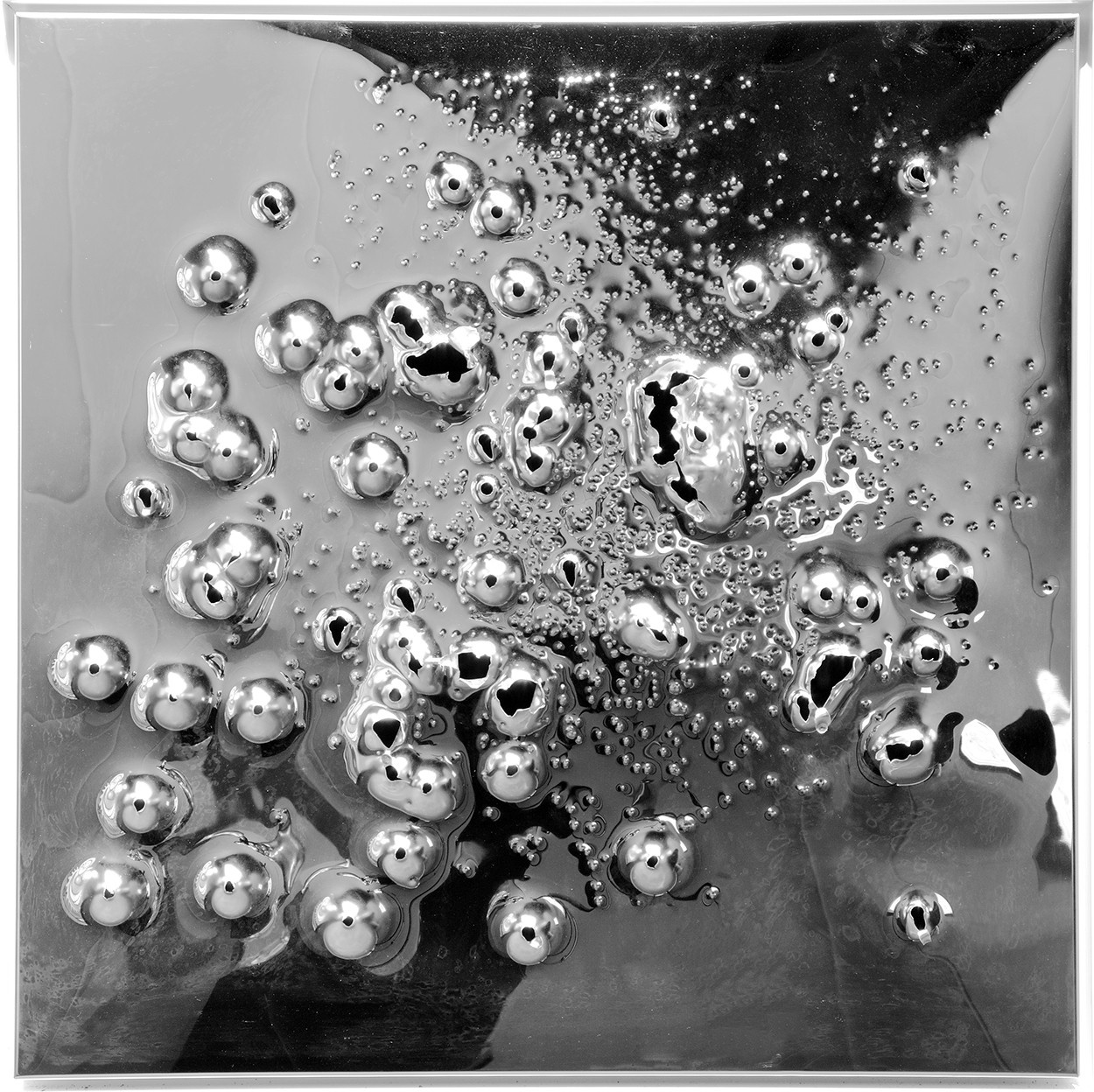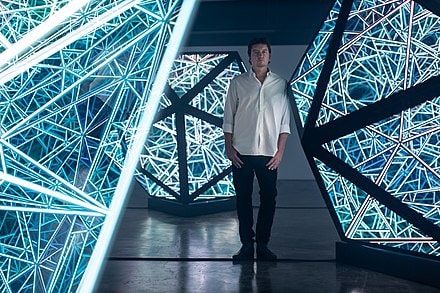It's rather unusual to see the gallery-goers at an art opening not just connecting, chatting or glancing at what's up on the wall or on a stand, but as wholly immersed in the art as if being swallowed down Alice's rabbit hole. That though was what I saw at the show of Anthony James's Portals in the large ground floor space alongside the entrance to 425 Park Avenue. These Portals are multi-facetted shapes which James has fabricated from titanium, glass and LED lighting, and they represent Platonic Solids, so named because they were identified by Plato, the 5th century Greek philosopher, who considered these five geometric forms - the octahedron, the dodecahedron, the icosahedron, the pyramid and the cube - to be the roots of creation.
Before entering the Portals though I'll revisit the Birch series, the work I saw by James in the early 2000s. He was a recent arrival in New York, a British artist in his twenties, who was strongly drawn to Minimalism and Formalism. "One of the things about Minimalism and Formalism is their theatricality," he said. "That is the primary source of how I make my art, I put specific objects into a grill system." A telling turn of phrase, this. "Specific objects" had been the phrase that Donald Judd, an artist James reveres, preferred to the word Sculpture to describe his own work. And the Birch series, upon which James launched himself in 2005, consisted of lightboxes in which he had installed segments of white birch trees and so positioned interior mirrors and LEDs that a viewer felt he or she were standing in a birchwood that went on forever.

Anthony James Birch Cube
There was more to this though than Minimalist purity. "Birch trees are in nature but they are also very modern," James said. "They were the first trees to line Paris boulevards when Paris was the first modern city. When they grow in nature they are overwhelming. They look infinite. You can get lost so easily in amongst them. They grow beside lakes and rivers and you get these reflections so you are completely overwhelmed by these white columns from all angles. I've always tried to contain within my sculptures a different kind of universe. I wanted to make a futuristic forest but contain it like a relic - a time capsule."
In 2008 James made a further art decision. He had been dazzled by great motorcars since boyhood and was doing well enough at 30 to buy his own. He chose a Ferrari 355 Spyder, which became at once his most prized possession. James though strongly believes that a sacrifice can play a crucial part in the making of strong art. He knew that the ancient Greeks sacrificed to the gods in woodlands, so he drove to Kingston in Upstate New York, entered a birch forest close to the Hudson river, and settled down to the initially tricky process of setting his beloved Spyder alight. "The magnesium wheels melted first," he says. It then exploded like a bomb - "It was a beautiful wreck," he adds.
James installed the wreckage in a glass box, 96 x 192 x 96", with elements of aluminium, black steel, fluorescent lights and segmented birch logs. He called the piece, Kalos Thanatos, Greek for Beautiful Death and sent it out to several shows at which it was regularly a knock-out, being often compared for its impact to Damien Hirst's shark. James had arrived on the global art scene with, almost literally, the proverbial bang.

Anthony James Kalos Thanatos
The Ferrari, was a one off but it was also in 2008 that James made his first Platonic Solid. He had no blueprint. "When I wake up I'm one of those guys who makes a lot of drawings," he says. "But the digital artwork that I made in early and mid 2000, I didn't draw them or work them out. I would go down to Canal Street and visit the hardware shops. I would just go, look." When he found the right stuff amongst the hardware store merch, he would get to work.
"Sometimes I would repeat it so many times that the fabrication was near perfect," James says. "Because I don't want the viewer to be thinking about how this object was made. I want it to be as simple as looking at a tree. Of course it's not. But I don't want that to be part of the discussion. I just want them to look at it and have thoughts about themselves. Maybe some philosophy about themselves, about the divinity within oneself.." He called that first Platonic Solid, Portal Icosahedron and showed it but it didn't get much attention. "It takes patience," he says.
James was led into his next body of work by his thinking about the work of Lucio Fontana, the Argentinian painter and sculptor, who was given to slicing, slashing or puncturing canvas, paper, or whatever surface or object he chose. "I was thinking of his trajectory towards a demonstration of what the universe could be," James says.
"Like when he would push a pencil through a sheet of paper; out of chaos comes creation and randomization - and that's what I was going for".
So to the Bullet Series which he launched into in 2011. Thanatos had just looked like an accident, in the Bullet Series he harnessed the real thing, shooting up sheets of mirror-polished steel with the formidable armory that he had put together, included a Benelli shotgun, and an AK47. The gnarly, chewed-up, pearly, nacreous, glimmery steel surfaces of the works in the Bullet series have plainly been created by death-dealing weaponry, so each piece is at once an abstraction but loaded with dark meaning, giving each piece a highly-charged presence.
James got back to work on the Portals series. "I knew this would be an important body of work for me," he says. "We had a show worked out in New York in 2012". Poor timing. Hurricane Sandy hit, New York was underwater, much of his work was destroyed. "I went back to LA, broke. I felt very down on my luck," he says. "So I moved to Munich, Germany, I felt quite lost in my life. But I felt that something was happening and I didn't quite know quite what it was. I wasn't making artworks but you can't escape yourself. I started collecting cardboard boxes on the street and taking them back to my apartment and then one day on one of my walks I came across a foundry."

Anthony James Bullet Painting
James rented that foundry. "I brought my boxes there and dumped them in wax. I started manipulating them, sculpting them, and then I put them into plaster." The end results, which he called Morphic Fields, are jagged cast bronzes on bases of found limestone, and they are at once identifiably the product of his eye and wholly unlike his other work.
So back to the beginning. Such an off-the-art-battlefield thing as a popular movie seldom affects a working artist's career but so it was when Portal Icosahedron showed its multiple faces in the 1922 themed murder mystery, Glass Onion, which centered around a tech billionaire art collector. The James Portal features prominently in his collection, a pictorial supporting cast which includes work by Matisse, Cy Twombly, Hockney, Basquiat and a Rothko, which the moviemaker slyly hung upside down. Glass Onion starred Daniel Craig, a former James Bond, as the detective, was a smash and remains piping hot on Netflix, and Platonic Solids would become a force field for Anthony James.
James began by making the works for himself and it was an ambitious project from the get go. "I wanted to visually demonstrate the ever expanding cosmos, the universe," he says. "I wanted people to see infinity." And not just the universe of the scientists, the telescopes, the space programs. "I wanted to bring in some spirituality, to make work that physically expressed the divinity inside oneself," he says.
Not the usual art lingo, this, but James brings in some science back-up, referencing the way that molecules will congregate into natural, organic shapes and the possible uses of computer programming to facilitate such processes in art.
Has he thought of channeling AI as such a tool?
"I have dabbled in AI - I think it's fascinating," James said. "AI has a wonderful signature of its own. Maybe AI is just a form of the collective consciousness, and everything that has ever been put on the Internet is just a fraction of the universe. I find AI quite natural."
